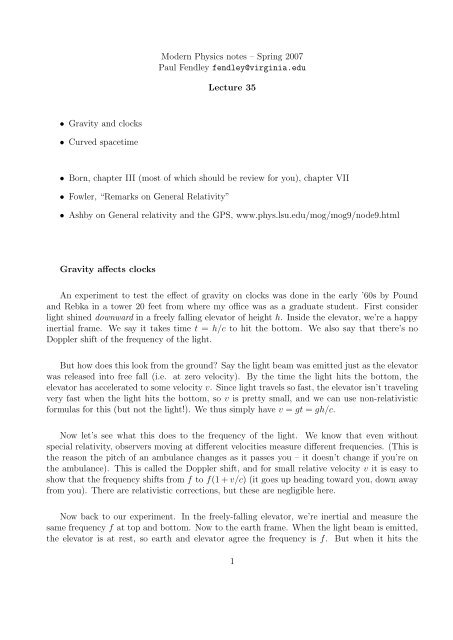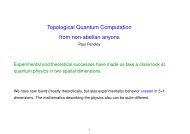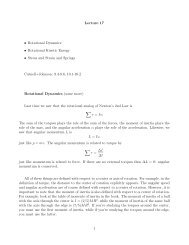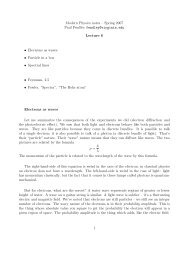Lecture 35 - Paul Fendley
Lecture 35 - Paul Fendley
Lecture 35 - Paul Fendley
You also want an ePaper? Increase the reach of your titles
YUMPU automatically turns print PDFs into web optimized ePapers that Google loves.
Modern Physics notes – Spring 2007<br />
<strong>Paul</strong> <strong>Fendley</strong> fendley@virginia.edu<br />
<strong>Lecture</strong> <strong>35</strong><br />
• Gravity and clocks<br />
• Curved spacetime<br />
• Born, chapter III (most of which should be review for you), chapter VII<br />
• Fowler, “Remarks on General Relativity”<br />
• Ashby on General relativity and the GPS, www.phys.lsu.edu/mog/mog9/node9.html<br />
Gravity affects clocks<br />
An experiment to test the effect of gravity on clocks was done in the early ’60s by Pound<br />
and Rebka in a tower 20 feet from where my office was as a graduate student. First consider<br />
light shined downward in a freely falling elevator of height h. Inside the elevator, we’re a happy<br />
inertial frame. We say it takes time t = h/c to hit the bottom. We also say that there’s no<br />
Doppler shift of the frequency of the light.<br />
But how does this look from the ground? Say the light beam was emitted just as the elevator<br />
was released into free fall (i.e. at zero velocity). By the time the light hits the bottom, the<br />
elevator has accelerated to some velocity v. Since light travels so fast, the elevator isn’t traveling<br />
very fast when the light hits the bottom, so v is pretty small, and we can use non-relativistic<br />
formulas for this (but not the light!). We thus simply have v = gt = gh/c.<br />
Now let’s see what this does to the frequency of the light. We know that even without<br />
special relativity, observers moving at different velocities measure different frequencies. (This is<br />
the reason the pitch of an ambulance changes as it passes you – it doesn’t change if you’re on<br />
the ambulance). This is called the Doppler shift, and for small relative velocity v it is easy to<br />
show that the frequency shifts from f to f(1 + v/c) (it goes up heading toward you, down away<br />
from you). There are relativistic corrections, but these are negligible here.<br />
Now back to our experiment. In the freely-falling elevator, we’re inertial and measure the<br />
same frequency f at top and bottom. Now to the earth frame. When the light beam is emitted,<br />
the elevator is at rest, so earth and elevator agree the frequency is f. But when it hits the<br />
1
ottom, the elevator is moving at velocity v = gh/c with respect to the earth, so earth and<br />
elevator must measure different frequencies. In the elevator, we know that the frequency is still<br />
f, so on the ground the frequency<br />
f ′ = f(1 + v/c) = f(1 + gh/c 2 )<br />
On the earth, we interpret this as meaning that not only does gravity bend light, but changes<br />
its frequency as well.<br />
If you start the light beam at the bottom, then the frequency measured on earth decreases –<br />
it is shifted to the red. Thus light escaping from a very massive star undergoes a gravitational<br />
red shift. This can be observed as well, by measuring the spectral lines from these stars and then<br />
comparing to those on earth. but Pound and Rebka measured this effect directly in the tower<br />
by my office. Note that with the ∼ 20 m tower in a four-story building, this requires measuring<br />
a variation in frequency to about 1 part in 10 15 . Now, using atomic clocks, this effect is easily<br />
measured.<br />
So now forget the elevator – we’ve shown that light in a gravitational field shifts its frequency.<br />
This means that clocks at different altitudes measure time differently in the presence of gravity!<br />
This is like time dilation, except here nothing needs to be moving – the gravitational field does<br />
it. The time between ticks ∆t is 1/f, so<br />
∆t sat<br />
∆t earth<br />
= f earth<br />
f sat<br />
≈ (1 + gh/c 2 )<br />
for a satellite at height h. The earth measures a shorter time between ticks than does the<br />
satellite. This means we on earth see the clock on the satellite as running faster. The standard<br />
clock in Boulder, CO (5400 feet) runs 6 microseconds a year faster than the clock at sea level<br />
in Greenwich, England. (Atomic clocks have an accuracy of about a microsecond a year.)<br />
There is even a practical application of this result: the GPS consists of satellites in orbit<br />
with atomic clocks. Your GPS device gets signals from multiple satellites, each encoded with<br />
the information of what time and at what position the signal was sent. Since we know the speed<br />
of light, you can then figure out your exact position if there are at least three satellites. The<br />
speed of light is about one foot per nanosecond, so an error of one nanosecond is about one foot.<br />
On the homework, you’ll work out by how much the clocks on the satellite change relative to<br />
the earth every day. The time you get from the clock thus must be corrected to compensate for<br />
this. It also must be corrected for the time dilation due to special relativity (the motion of the<br />
satellite – they go around the earth every twelve hours).<br />
Spacetime is curved<br />
So light is bent by gravity, and clocks at different altitudes run at different speeds. How do<br />
we generalize Lorentz transformations to account for frames accelerating with respect to each<br />
2
other, or, equivalently, in a gravitational field? The whole story is called general relativity,<br />
and to really quantitatively understand what’s going on requires a fair amount of mathematical<br />
sophistication. The area of math involved is called differential geometry, and what it involves is<br />
understanding how to do calculus on surfaces which are curved, such as the surface of a sphere.<br />
So why do we need to understand calculus on surfaces which are not flat? The fact that light<br />
curves means that the quickest way of getting from one point to another in a gravitational field is<br />
not a straight line! Thus if there is gravity present, we can’t use rigid rods to measure a distance<br />
or a single clock to measure a time interval the way we did in special relativity. Spacetime itself<br />
is curved.<br />
Why is space time curved? We can apply these ideas to a merry-go-round in outer space. In<br />
the frame of the merry-go-round, you feel a centrifugal force outward: it’s mω 2 R. If you don’t<br />
know about the motor of the merry-go-round, you can’t distinguish that from the possibility<br />
is that you’re in a horizontal gravitational field of strength ω 2 R pointing way from the merrygo-round<br />
(say coming from some enormous asteroid). This is analogous to, but reversed from,<br />
free fall. Both frames agree that the other accelerating with respect to them. One frame in<br />
each case says there’s gravity. But here it’s the merry-go-round which says there’s “horizontal<br />
gravity” (the centrifugal force). With the elevator in free fall, they say there’s no gravity, while<br />
the ground says there is.<br />
Now let’s measure the ratio of the circumference of the merry go round. On the ground (here<br />
the inertial frame), we place many short sticks of fixed length L around the edge of the merry<br />
go round, and radially from the center. Since the sticks are straight, this gives a slight error,<br />
but as we increase the number of sticks, the error decreases. Denote N edge the number of sticks<br />
around the edge, and N radial the number of sticks pointing radially. As we use a larger number<br />
of shorter sticks, we find of course<br />
N edge<br />
N radial<br />
= N edgeL<br />
N radial L = C R = 2π<br />
Since the ground is an inertial frame, we interpret this as meaning that the ratio of the circumference<br />
C to the radius R is 2π as Euclidean geometry says. Now let’s interpret this from<br />
the merry-go-round. Because each point on the edge is moving with some speed v = ωR with<br />
respect to the sticks on the ground, people on the merry-go-round see each stick of length L<br />
contracting, so that they measure L ′ = L/γ. The radial sticks, however, are still measured at the<br />
same length L, because the motion is perpendicular to them. The merry-go-round and people on<br />
the ground of course agree on the number of radial sticks N radial and the number of sticks N edge<br />
around the circumference (an integer can’t change between frames!). What they do not agree<br />
on is the length of the circumference. They would say that the circumference is C ′ = N edge L ′ ,<br />
so that C ′ = C/γ. Comparing with before.<br />
2π = N edge<br />
N radial<br />
= N edgeL<br />
N radial L = C′<br />
R ′ γ<br />
Thus on the merry-go-round, we have for a circle C = 2πγR. This is not Euclidean geometry!<br />
3
But from the equivalence principle we know that this the merry-go-round can be interpreted<br />
as a frame at rest in a gravitational field. Thus gravity bends space. You can come up with<br />
arguments like this for time as well. This means that in the presence of gravity, spacetime is<br />
curved!<br />
As no doubt you know, once you’re on a curved space like a sphere, measuring things gets<br />
trickier. For example, if I draw a circle on the surface of a sphere, it’s obvious that C ≠ 2πR if<br />
we define all distances to remain on the sphere. The Pythagorean theorem fails as well.<br />
First, let me give a more precise definition of what curved is. Take 12 equal-length rods, and<br />
arrange them in a hexagon with spokes. If you can do this on some surface, we say that the<br />
surface is flat at this point. But on say on the top of a mountain, one rod is too long. That’s<br />
called “positive” curvature. But on a saddle, one of the rods isn’t long enough. That’s called<br />
negative curvature.<br />
So how do we quantify this? As I said, to really do this right requires a lot of math. But<br />
some useful facts from special relativity show at least how to set things up. We learned there<br />
that already things are complicated: length contraction and time dilation occur even without<br />
acclerating frames. But we did learn the interval ∆ is the same in any frame. Thus without<br />
gravity, we can say that √ ∆ is the “distance” between two events in spacetime. What this<br />
means is that for two space like events, i √ ∆ is the distance between the two events in the frame<br />
where they are simultaneous. For two timelike events, √ ∆ is the time interval between the two<br />
events in a frame where the events are at the same place (i.e. the “rest” frame).<br />
In special relativity, ∆ is like a distance, except for the funny minus sign. Say that two events<br />
are close together in space so that dt = t 2 − t 1 and d⃗x = ⃗x 2 − ⃗x 1 . We say that the distance d∆<br />
between two events close together in space time is<br />
d∆ = √ 3∑<br />
c 2 (t 2 − t 1 ) 2 − (x 2 − x 1 ) 2 − (y 2 − y 1 ) 2 − (z 2 − z 1 ) 2 = √ c2 (dt) 2 −<br />
where dx 2 = dy, etc. We say that this spacetime (no gravitational fields) is flat. Roughly<br />
speaking, it means that the coefficients of the terms on the right-hand-side do not depend on<br />
space or time. Note that this is basically the Pythagorean theorem with minus signs.<br />
i=1<br />
dx 2 i<br />
So this sounds horribly complicated. But here’s the rule. Even on curved surfaces, there<br />
is still a notion of “shortest path”. For example, on the earth, the shortest path follows great<br />
circles. To get from here to Korea, you fly over the Arctic Ocean and Siberia. (Really!) A great<br />
circle is the edge of a disc slicing the earth in half. To measure the shortest distance in a curved<br />
spacetime, there is a formula for d∆ but now where the coefficients depend on space and maybe<br />
4
time too. To write down a nice equation, let x 0 = ct, so dx 0 = cdt<br />
∑<br />
d∆ = √ 3 3∑<br />
g µν (t, ⃗x)dx µ dx ν<br />
µ=0 ν=0<br />
where the 16 functions g µν are called the metric. If there is no curvature (i.e. no gravity) then<br />
we have g 00 = 1, g 11 = g 22 = g 33 = −1, and g µν = 0 if µ ≠ ν. Now we can determine the shortest<br />
path simply by finding ∆ for all paths between the two events: the one with the smallest |∆ is<br />
the shortest one. This path is called a geodesic. (I have no idea why Born calls it a “geodetic”.)<br />
Sorry for the mathematical diversion. Here’s what it has to do with gravity. An object in free<br />
fall follows geodesics, i.e. the shortest path in spacetime. By “free fall” we mean in the absence of<br />
all external fields. Thus even in the presence of gravity, “free” particles follow the shortest path<br />
in spacetime! When gravity is present, these paths seem curved to a observer who feels gravity’s<br />
force. (i.e. some one not in free fall). In special relativity, the shortest paths are straight lines.<br />
Once the coefficients in the above equation for d∆ (the metric) start to depend on space and<br />
time, this is no longer true.<br />
To reiterate: we have said if there is no gravity, then everything reduces to special relativity:<br />
spacetime is flat. But of course there is only no gravity if there is no matter: a world of light<br />
only is not particularly interesting. When there is gravity, then light no longer travels in straight<br />
lines. The more matter, the more gravity, and the more curving things do.<br />
5











